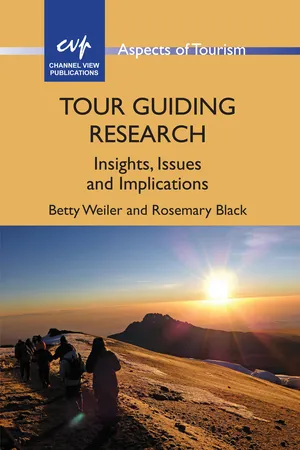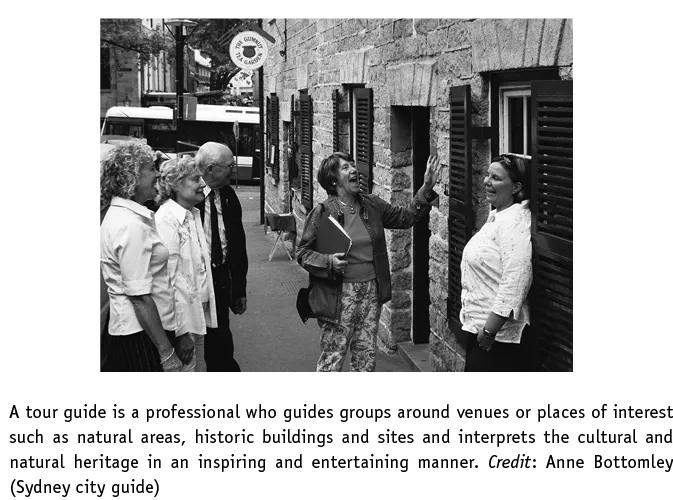![]()
1 The Historical and Political Context and Scope of Tour Guiding Research
Introduction to and Aim of the Book
Tour guides can be found at every tourism destination, and nearly everyone both within and outside the tourism industry is familiar with the term and the persona of a ‘tour guide’. Few, however, fully understand what a tour guide does and what constitutes ‘tour guiding’.
Whether employed by tour operators, resorts, lodges, attractions, theme parks, museums, protected area management agencies, zoos, visitor centres or self-employed, tour guides are often viewed by other stakeholders as an important part of, and sometimes as the key player in, the tourism product and experience. However, it is only quite recently that scholars and researchers have turned their attention to the subject of tour guides and tour guiding. The earliest book on the phenomenon of tour guiding appears to be E.A. Mills’ (1920) Adventures of a Nature Guide; however, the earliest scholarly publication, Valene Smith’s call for trained tour guides, was published much later in the Professional Geographer in 1961. Some 50 years on, it is timely and appropriate to undertake a critical review of the scholarly literature on tour guides and guiding.
Prior to Cohen’s (1985) seminal paper on the role of the tour guide, published in Annals of Tourism Research, there were fewer than a dozen published papers on tour guides or guiding. However, conceptual and empirical papers have gradually found their way into conference proceedings, edited books and scholarly journals, so that there are now close to 300 published papers that focus specifically on some aspect of tour guides or tour guiding. The majority of these are empirical studies which, together with the conceptual literature, provide a substantial body of work from which to consider, reflect on and speculate about tour guiding as a phenomenon of interest.
Many scholars have argued that the tour guide plays a pivotal role in the experience of visitors or tourists who join a guided tour, potentially making or breaking the tour and the experience. Researchers acknowledge the instrumental role of the guide in ensuring that the tour runs smoothly and is a safe, logistical success, but increasingly emphasise the many mediatory and interpretive aspects of guiding. This in turn has drawn attention to the importance of the communicative competency of guides, including the application of best practice principles in interpretation and intercultural communication. The guide’s role in fostering sustainability has also come under scrutiny, particularly in influencing and monitoring visitors’ behaviour in contexts such as ecotourism and nature-based tourism and in delivering messages that impact post-visit attitudes and behaviour. Research has also begun to explore and measure the influence of these and other aspects of guiding on visitor satisfaction. In part to maintain and improve satisfaction but also to contribute to sustainability, the academic literature on tour guiding has examined the strengths and weaknesses of guide training and education initiatives and has evaluated training approaches that can further enhance the performance of tour guides. Finally, professional associations, professional certification, licensing and codes of practice have been researched for their potential to achieve quality assurance outcomes and to ensure that guides are recognised and rewarded for achieving these outcomes.
These and other themes provide the structure for this book. The aim of the book is to provide an authoritative, state-of-the-art review of the scholarly literature on tour guiding theory and practice to stimulate further research on tour guiding by social scientists across a range of disciplines and to foster quality tour guiding practice.
Specifically, this book seeks to:
- explore how tour guiding theory and practice from a range of disciplines have evolved over time and what factors have contributed to this;
- critically examine tour guiding research, methods, findings to date and research gaps;
- consolidate and synthesise the knowledge base on tour guiding and foreshadow how current and future trends and issues might impact on tour guiding research and practice in the 21st century.
As such, the book draws on the published literature on tour guiding, which in recent years has grown in both depth and breadth. The studies reviewed in this book cover a wide range of contexts in which guided tours are conducted, ranging from city streets to heritage and wildlife tourism attractions, from high-end tourist lodging establishments to national park campgrounds, and from highly developed destinations to very remote ones in both developed and developing countries.
Within the tourism literature, terms such as ‘tour guide’, ‘tourist guide’, ‘tour leader’, ‘tour manager’, ‘tour escort’ and ‘courier’ are sometimes used synonymously. The literature and industry terminology indicates that the use of these terms varies from country to country, region to region, between the public and private sectors and also within the tourism industry itself. In this book, a tour guide is defined as a person, usually a professional, who guides groups (and sometimes individuals) around venues or places of interest such as natural areas, historic buildings and sites, and landscapes of a city or a region; and interprets the cultural and natural heritage in an inspiring and entertaining manner, in the language of the visitor’s choice (adapted from the European Federation of Tourist Guide Associations [EFTGA]). It must be acknowledged, however, that the World Federation of Tourist Guide Associations (WFTGA) and the EFTGA consider the designation of ‘tour guide’ as inappropriate, unflattering and a misnomer, as the term can refer to a book, a brochure (Pond, 1993) or a robotic tour guide (Tomatis et al., 2002: 1). This is why the term ‘tourist guide’ rather than ‘tour guide’ is used extensively throughout Europe and the United Kingdom, defined as ‘a person who guides visitors in the language of their choice and interprets the cultural and natural heritage of an area, [and who] normally possesses an area-specific qualification usually issued and/or recognised by the appropriate authority’ (WFTGA, 2013). Much of this book, as will become evident, is relevant to others who work beyond such site- or area-specific guiding, such as tour guides, managers, leaders and escorts who move between destinations. In this book, the term ‘tour guiding’ is used to refer to the work undertaken by all of these people.
Elements common to all such tour guides are that they generally lead and manage groups who are normally non-captive in a communicative sense (they don’t have to pay attention) but are often captive in a physical sense (it is difficult for individuals to leave the tour or for the tour to discharge the guide) (see for example Macdonald, 2006 and others). Guided tours also typically involve direct experiences of phenomena (as opposed to virtual experiences such as via technology and mass media). For most guided tours there is one guide per group, there is opportunity for the guide to adjust his or her content and style to the group, and there are options for two-way communication and other forms of involvement/interaction by group members. Variations to the norm and different types of guided tours are discussed later in this chapter.
Overview of Tour Guiding Research and Scholarship
The theoretical and empirical research assembled for this book provides for the first time an overview of tour guiding research and scholarship over the past 50 years. This section first presents the methods used to undertake a review of the literature that forms the basis of this book. It then provides a snapshot of that research viewed as an aggregate, including where the research was published, the authors’ locations and disciplinary perspectives, the tourism genre in which the studies were undertaken, the study locations and the methods used.
Methods for researching, delimiting and writing about tour guides and guiding
The scholarly body of literature on which this book is based was identified using search engines such as Google Scholar together with library databases such as CAB Abstracts and leisuretourism.com, searching mainly for peer-reviewed journal papers and book chapters focused on tour guiding and tour guides. Some peer-reviewed conference papers, textbooks, doctoral-level theses and grey literature, such as government reports, were uncovered in searches and if accessible they were included. However, articles appearing in professional (non-peer-reviewed) publications such as tour guiding newsletters, magazines and internal government/organisational publications, as well as information conveyed via websites and in electronic media such as promotional and training videos/DVDs were not systematically searched.
Thus, this book’s focus and most of its analysis of tour guiding research and practice are limited primarily to what has been reported in the academic literature. A database was created of journal articles, books, book chapters, conference papers, doctoral theses and research reports published over the past 50 years. Some of these were studies examining broader aspects of tourism such as sustainable tourism, visitor communication/interpretation, customer service/satisfaction, tourism marketing and tourism/destination management, with tour guides or guiding forming only a part of the overall study or paper, but most (280) were tour guide/guiding focused. The detailed content of some publications that could not be obtained electronically is not reported in this book, although hard copies or PDFs were collected and reviewed for approximately 90% of the articles that were tour guiding focused. Eight books were identified that focus on tour guiding, nearly all of which are textbooks or manuals written for tour guides (both prospective and current) rather than books about guides and guiding. Two of these are particularly notable for their depth and breadth of focus (Pastorelli, 2003; Pond, 1993); the remaining are much shorter and narrower in focus.
Some anomalies were identified and subsequently excluded from the book using this search method, but are worth mentioning. Literature on interpretation and visitor communication delivered by non-personal and non-guided media is largely outside the scope of this book (for recent examples, see Kang and Gretzel [2012] on podcast tours and Chu et al. [2012] and Wolf et al. [2013] on Global Positioning System-triggered multimedia guided tours), and this includes research about guidebooks (sometimes referred to as ‘tour guides’) (Peel et al., 2012). Another line of enquiry outside the book’s focus is research reporting on the development and testing of electronic ‘tour guides’. First appearing in the academic literature in the late 1990s, Davies (1998) and others report on handheld, computer-based (smartphone) hardware and software applications developed as non-guided tour guiding services for visitors. Some of these city-focused guides are described as ‘interactive’, but this simply means that they incorporate user data to customise the service to each visitor with no interface with a human being. Similarly, there is some literature on the development of interactive robotic tour guides for use in museums and similar environments, designed to give visitors a ‘pre-defined tour’ (Tomatis et al., 2002: 1). Since none of these are about personal (human) tour guides, they have been excluded. Finally, Edelheim (2009) suggests th...

